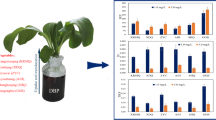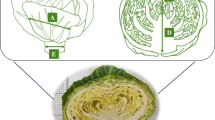Abstract
Although azoxystrobin has been widely applied on various crops, little is known about the bioavailability of azoxystrobin in the soil-vegetable system. In this study, the uptake, accumulation and translocation of azoxystrobin as affected by soil characteristics and plant species were respectively investigated. The accumulation amount of azoxystrobin in pakchoi increased as soil adsorption decreased and was positively associated with its concentration in pore water (Cpw), which was mainly affected by soil organic matter content. Therefore, Cpw could be a candidate for the estimation of azoxystrobin accumulation in pakchoi. In all the tested vegetables, azoxystrobin was mainly accumulated in roots, and its upward translocation was limited. Root lipid content was a major factor affecting the uptake and translocation of azoxystrobin in different vegetables.




Similar content being viewed by others
References
Bartett DW, Clough JM, Godfrey CRA, Godwin JR, Hall AA, Heaney SP, Maund SJ (2001) Understanding the strobilurin fungicides. Pesticide Outlook 12:143–148
Bending GD, Lincoln SD, Edmondson RN (2006) Spatial variation in the degradation rate of the pesticides isoproturon, azoxystrobin and diflufenican in soil and its relationship with chemical and microbial properties. Environ Pollut 139:279–287
Briggs GG, Bromilow RH, Evans AA (1982) Relationships between lipophilicity and root uptake and translocation of non-ionized chemicals by barley. Pesticide Sci 13:495–504
Chuang YH, Liu CH, Sallach JB, Hammerschmidt R, Zhang W, Boyd SA, Li H (2019) Mechanistic study on uptake and transport of pharmaceuticals in lettuce from water. Environ Int 131:104976
Clegg H, Riding MJ, Oliver R, Jones KC, Semple KT (2014) The impact of soil organic matter and soil sterilisation on the bioaccessibility of 14 C-azoxystrobin determined by desorption kinetics. J Hazard Mater 278:336–342
EFSA (2010) Conclusion on the peer review of the pesticide risk assessment of the active substance azoxystrobin.EFSA Journal.8
FAO M. Azoxystrobin: evaluation of data for acceptable daily intake and acute dietary intake for humans, maximum residue levels and supervised trial median residue values. https://www.fao.org/fileadmin/user_upload/IPM_Pesticide/JMPR/Reports/2008/AZOXYSTROBIN__229_.pdf. Accessed 10 November 2021
Guo G, Liu F, Bian Y, Li X (2018) Bitter gourd has the highest azoxystrobinon residue after open field application on four cucurbit vegetables. PLoS One 13:e0203967
Huang H, Zhang S, Christie P, Wang S, Xie M (2010) Behavior of decabromodiphenyl ether (BDE-209) in the soil-plant system: uptake, translocation, and metabolism in plants and dissipation in soil. Environ Sci Technol 44:663–667
Ju C, Li X, He S, Shi L, Yu S, Wang F, Xu S, Cao D, Fang H, Yu Y (2020a) Root uptake of imidacloprid and propiconazole is affected by root composition and soil characteristics. J Agric Food Chem 68:15381–15389
Ju C, Dong S, Zhang H, Yao S, Wang F, Cao D, Xu S, Fang H, Yu Y (2020b) Subcellular distribution governing accumulation and translocation of pesticides in wheat (Triticum aestivum L.). Chemosphere 248:126024
Ju C, Zhang H, Yao S, Dong S, Cao D, Wang F, Fang H, Yu Y (2019) Uptake, translocation, and subcellular distribution of azoxystrobin in wheat plant (Triticum aestivum L.). J Agric Food Chem 67:6691–6699
Kumar K, Gupta SC (2016) A Framework to Predict Uptake of Trace Organic Compounds by Plants. J Environ Qual 45:555–564
Li Y, Long L, Yan H, Ge J, Cheng J, Ren L, Yu X (2018) Comparison of uptake, translocation and accumulation of several neonicotinoids in komatsuna (Brassica rapa var. perviridis) from contaminated soils. Chemosphere 200:603–611
Li Y, Sallach JB, Zhang W, Boyd SA, Li H (2019) Insight into the distribution of pharmaceuticals in soil-water-plant systems. Water Res 152:38–46
Lin S, Tang T, Cang T, Yu S, Ying Z, Gu S, Zhang Q (2020) The distributions of three fungicides in vegetables and their potential health risks in Zhejiang, China: A 3-year study (2015–2017). Environ Pollut 267:115481
Liu K, Yu B, Luo K, Liu X, Bai L (2016) Reduced sulfentrazone phytotoxicity through increased adsorption and anionic species in biochar-amended soils. Environ Sci Pollut Res Int 23:9956–9963
Liu KL, Cao ZY, Pan X, Yu YL (2012) Using in situ pore water concentrations to estimate the phytotoxicity of nicosulfuron in soils to corn (Zea mays L.). Environ Toxicol Chem 31:1705–1711
Liu Q, Liu Y, Dong F, Sallach JB, Wu X, Liu X, Xu J, Zheng Y, Li Y (2021) Uptake kinetics and accumulation of pesticides in wheat (Triticum aestivum L.): Impact of chemical and plant properties. Environ Pollut 275:116637
Miller EL, Nason SL, Karthikeyan KG, Pedersen JA (2016) Root uptake of pharmaceuticals and personal care product ingredients. Environ Sci Technol 50:525–541
OECD (2000) OECD Guideline 106-OECD guideline for the testing of chemicals: adsorption-desorption using a batch equilibrium method, Paris, France
Park DW, Kim KG, Choi EA, Kang GR, Kim TS, Yang YS, Moon SJ, Ha DR, Kim ES, Cho BS (2016) Pesticide residues in leafy vegetables, stalk and stem vegetables from South Korea: a long-term study on safety and health risk assessment. Food Addit Contam Part A Chem Anal Control Expo Risk Assess 33:105–118
Qin G, Chen Y, He F, Yang B, Zou K, Shen N, Zuo B, Liu R, Zhang W, Li Y(2021) Risk assessment of fungicide pesticide residues in vegetables and fruits in the mid-western region of China.J Food Compos Anal.95
Romeh AA (2015) Evaluation of the phytoremediation potential of three plant species for azoxystrobin-contaminated soil. Int J Environ Sci Te 12:3509–3518
Silva V, Mol HGJ, Zomer P, Tienstra M, Ritsema CJ, Geissen V (2019) Pesticide residues in European agricultural soils - A hidden reality unfolded. Sci Total Environ 653:1532–1545
Sudoma M, Neuwirthova N, Hvezdova M, Svobodova M, Bilkova Z, Scherr KE, Hofman J (2019) Fate and bioavailability of four conazole fungicides in twelve different arable soils - Effects of soil and pesticide properties. Chemosphere 230:347–359
Wang F, Li X, Yu S, He S, Cao D, Yao S, Fang H, Yu Y (2021) Chemical factors affecting uptake and translocation of six pesticides in soil by maize (Zea mays L.). J Hazard Mater 405:124269
Wu P, Wu WZ, Han ZH, Yang H (2016) Desorption and mobilization of three strobilurin fungicides in three types of soil. Environ Monit Assess 188:363
Wu X, Zhu L (2016) Evaluating bioavailability of organic pollutants in soils by sequential ultrasonic extraction procedure. Chemosphere 156:21–29
Yang CY, Chang ML, Wu SC, Shih YH (2016) Sorption equilibrium of emerging and traditional organic contaminants in leafy rape, Chinese mustard, lettuce and Chinese cabbage. Chemosphere 154:552–558
You X, Suo F, Yin S, Wang X, Zheng H, Fang S, Zhang C, Li F, Li Y(2021) Biochar decreased enantioselective uptake of chiral pesticide metalaxyl by lettuce and shifted bacterial community in agricultural soil.J Hazard Mater.417
Yu X, Shen T, Kang X, Cui Y, Chen Q, Shoaib M, Liu H, Zhang F, Hussain S, Xiang Q, Zhao K, Gu Y, Ma M, Li S, Zou L, Liang Y(2021a) Long-term phytoremediation using the symbiotic Pongamia pinnata reshaped soil micro-ecological environment.Sci Total Environ.774
Yu SM, L X, He SH, Zhang HC, Jin MJ, Zheng YQ, Zhang LQ, Yu YL (2021b) Uptake and translocation of triadimefon by wheat (Triticum aestivum L.) grown in hydroponics and soil conditions. J Hazard Mater 423:127011
Zhang C, Feng Y, Liu YW, Chang HQ, Li ZJ, Xue JM (2017) Uptake and translocation of organic pollutants in plants: A review. J Integr Agr 16:1659–1668
Acknowledgements
This work was supported by the National Key Research and Development Program of China (2019YFC1604503), the National Natural Science Foundation of China (No. 21777141, 41977342), and the Fundamental Research Funds for the Central Universities (2021QNA6020).
Author information
Authors and Affiliations
Corresponding author
Additional information
Publisher’s note
Springer Nature remains neutral with regard to jurisdictional claims in published maps and institutional affiliations.
Rights and permissions
About this article
Cite this article
Xu, S., Song, J., Shen, F. et al. Uptake, Accumulation, and translocation of azoxystrobin by Vegetable plants in soils: influence of soil characteristics and plant species. Bull Environ Contam Toxicol 109, 386–392 (2022). https://doi.org/10.1007/s00128-022-03556-w
Received:
Accepted:
Published:
Issue Date:
DOI: https://doi.org/10.1007/s00128-022-03556-w




